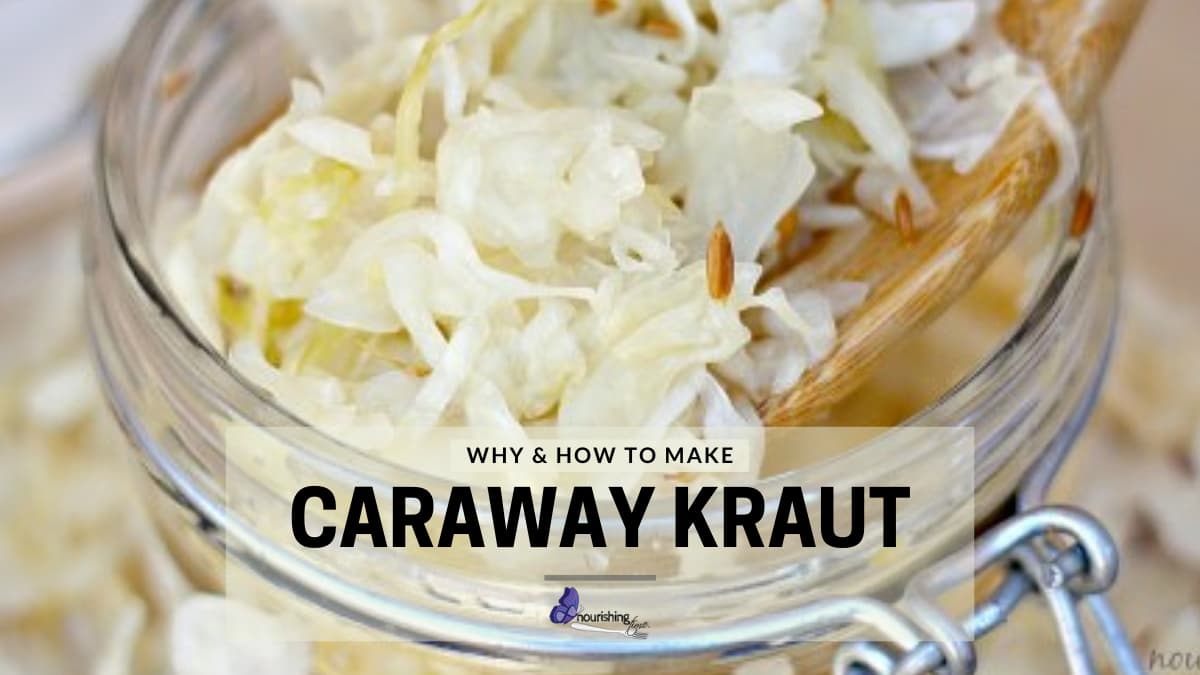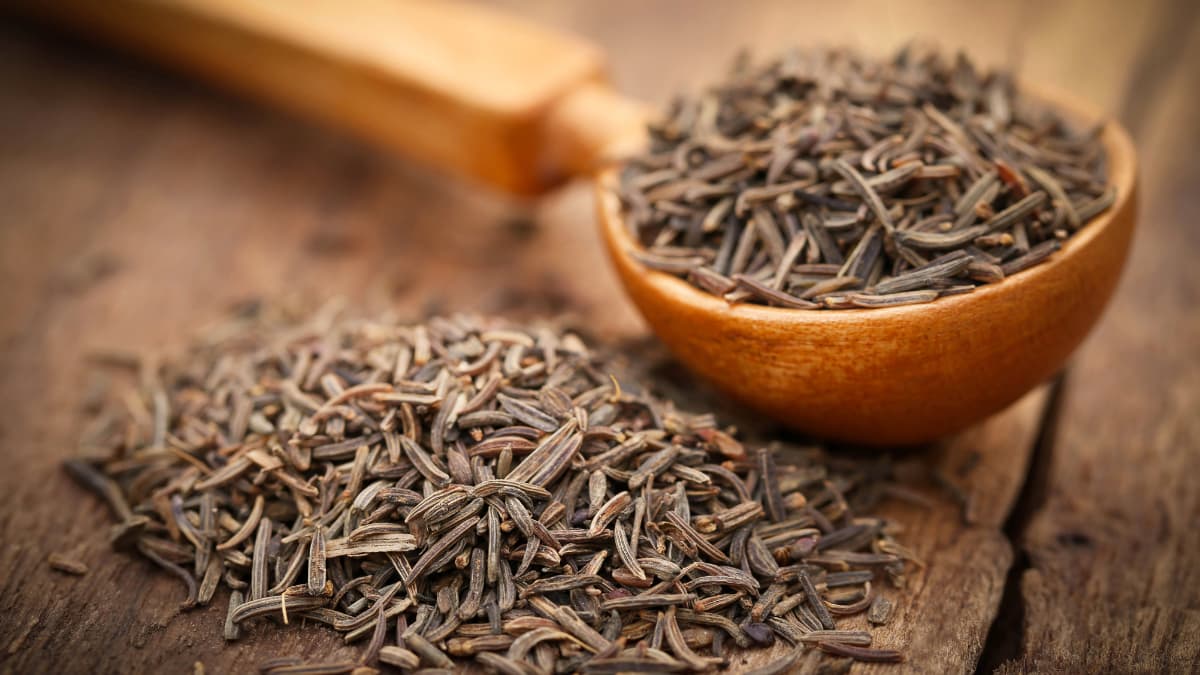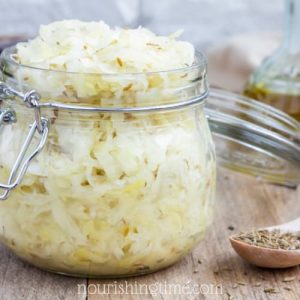I love experimenting with flavored krauts such as this caraway sauerkraut recipe! Sauerkraut with caraway seeds tastes good and offers some health benefits as well!

But how do you make caraway sauerkraut? And how many caraway seeds do you add? Do you add prior to fermenting your kraut or afterwards? And what if you end up with caraway sauerkraut that has too much caraway flavor?
In this post I will share how to make caraway sauerkraut and several reasons why you should!
You might also want to check out my recipe for beet caraway sauerkraut, which is a delicious (and beautiful!) variation!
What Are Caraway Seeds?

Caraway seeds are grown throughout Europe and Asia and have similar properties to other spices and herbs such as anise, fennel and valerian. The “seed” is actually the fruit!
What do caraway seeds taste like?
If you’ve never experienced the flavor of caraway for yourself, then it can be difficult to explain. It has an “earthy” flavor that some consider slightly nutty and bittersweet.
Caraway is very flavorful and has a unique taste flavor, so it is difficult to describe definitively. A small amount goes a long way!
What are caraway seeds used for?
Caraway seeds are used to flavor:
- breads
- alcohol
- cake
- cheese
- soup
- fruit
- dips
- cabbage
Caraway seeds are the most common type of seeds added to sauerkraut!
A curious superstition was held in olden times about the Caraway. It was deemed to confer the gift of retention, preventing the theft of any object which contained it, and holding the thief in custody within the invaded house. In like manner it was thought to keep lovers from proving fickle (forming an ingredient of love potions), and also to prevent fowls and pigeons from straying. It is an undoubted fact that tame pigeons, who are particularly fond of the seeds, will never stray if they are given a piece of baked Caraway dough in their cote. – Mrs. M. Grieve (Source 1)
What Are The Health Benefits of Caraway Seeds?
- Caraway seeds have carminative properties–they help relieve gas by preventing its formation and helping to expel it.
- They are very soothing to the gastrointestinal tract and so helps with digestive issues such as stomachaches/indigestion. They have been used to sooth colic, earaches, and can also help heal bruises when powdered and made into a poultice.
- They are rich in minerals such as calcium, magnesium, selenium, phosphorous and potassium. They also contains a variety of vitamins including Vitamin C.
- Caraway seeds are helpful for high blood pressure, cholesterol, gallbladder and kidney issues.
- The oil in caraway seeds is antihelmintic and antiseptic, so they effectively expel worms and infections from the body.
- They are useful for women trying to increase lactation or jump-start their periods, as well.
These health benefits are why you should put caraway seeds in sauerkraut. But what if you really don’t want to?
Can I make sauerkraut without caraway seeds?
Yes, you can make sauerkraut without caraway seeds. In fact, I make plenty of different sauerkraut flavors without putting any caraway seeds, or any seeds at all. Caraway is just ONE WAY out of MILLIONS to flavor sauerkraut. And if you do not like caraway, then you can totally leave them out of your homemade sauerkraut!
I will soon add plenty of flavoring ideas in an upcoming post on sauerkraut, but until then you can consider adding a variety of vegetables, whole spices, herbs, and harder fruit (such as apples, Asian pears, cranberries, etc.).
What is a good substitute for caraway seeds?
If you want to add seeds to your sauerkraut, but just do not have caraway on hand, then there are several spices you can use instead of caraway seeds in sauerkraut.
These are my favorite whole spices to substitute for caraway seeds:
- Juniper berries
- Fenugreek
- Fennel seeds
Fennel seeds will probably be your best bet for a caraway seed substitute in sauerkraut. However, you can also consider dill or anise seeds as a caraway seed substitute – these two are both more pungent.
Fenugreek will give slight sweetish maple syrup hint, while juniper berries are probably the most mild of these choices and one of my personal favorite additions to kraut.
Mix and match based on what pleases your taste buds!
How much caraway seed goes in sauerkraut?
The ideal amount of caraway seed in sauerkraut will depend on individual tastebuds. I like to put approximately 1 tsp per pound of shredded cabbage.
If you really LOVE the flavor of caraway, then you can opt for 2-3 tsp per pound of shredded cabbage. But going over 1 tablespoon will likely result in a flavor that is way too strong.
What if I add too many caraway seeds?
If you notice that you’ve added too many caraway seeds prior to fermentation, then you can stretch your batch by adding more cabbage and salt.
If you discover after fermentation, then your choices are to stretch with another batch of kraut such as plain sauerkraut, or to use this batch of sauerkraut for cooking so you can more easily adjust the flavor.
When should you put caraway seeds in sauerkraut?
If you are making a traditional caraway sauerkraut, you will add caraway seeds to the fresh cabbage, during the fermenting process. Adding caraway seeds to your sauerkraut before fermentation allows the seeds to impart their flavor throughout the sauerkraut.
Can I add caraway seeds to already-fermented kraut?
Yes, you can! The best method is to sauté the caraway seeds in olive oil and/or butter/ghee, and then add the sauerkraut. This will result in a dish that is delicious as a side to several different types of meat.
So… how do you make homemade caraway sauerkraut?
Making homemade sauerkraut with caraway seeds is very easy. You need a fermenting jar, fresh cabbage, caraway seeds, and salt.
You need to:
- shred the cabbage (I use this mandoline)
- weigh the cabbage and salt (I use this kitchen scale)
- mix the cabbage, salt and caraway seeds together
- pack into your fermenting jar (a kraut pounder can be helpful to pack and get out the air pockets)
- close fermenting jar and allow the fermentation process to do its magic!
It really couldn’t be easier to ferment sauerkraut with caraway seeds at home! See below for printable recipe with measurements, and let me know if you have any questions!


Caraway Sauerkraut Recipe
Ingredients
- 2 1/2 lbs cabbage (approximately)
- 2-3 tsp caraway seeds (I use 3 tsp/1 tbsp)
- 12 g salt (approximately)
Instructions
- Shred cabbage.
- Add caraway seeds and salt and mix well.
- Stuff into jar and press down as much as you can. Leave a few inches of head space.
- Close jar and let ferment for 24 hours, then check brine level. If cabbage is not well-submerged, you may need to add more water.
- Ferment at room temperature for 1-2 weeks (if your house is on the warmer side, you’ll ferment at room temperature for less time). Then move to the fridge where you will leave it an additional 9-10 weeks.
Notes
Caraway Kraut & The GAPS Diet
Sauerkraut made of things other than just cabbage and salt are allowed on the GAPS Diet. Any addition, of course, needs to be GAPS-legal and tolerated by the individual consuming the kraut. The same rules as “regular kraut” apply–start with only the juice of the ferment if necessary and slowly work your way up.
Most GAPS patients have multiple infections including parasitic ones. These patients also have an increased need for vitamins and minerals. Fermented foods are a very important part of the diet, and sauerkraut is one that should definitely be included. This short list of fermented foods for candida can also be helpful if you’re having trouble deciding which kinds of ferments to try next!
If you suffer from histamine intolerance, definitely get anaerobic fermenting vessels such as a Pickl-It and ferment your sauerkraut for 12 weeks or more. Here’s a list of fermenting supplies I recommend.
Sauerkraut is amazing for many GAPS complaints such as constipation, diarrhea, low stomach acidity, issues digesting fat, heartburn, indigestion, stomach aches, detoxification and more.
The addition of caraway seeds definitely adds to these benefits!
Do you really ferment sauerkraut for 12 weeks+?
Yes, I ferment my sauerkraut for a full 12 weeks and it is delicious! To accomplish this, generally you have to ferment in an anaerobic vessel.
You can read more about why I ferment anaerobically here.
If you are using a method of fermentation that differs from mine, you may want to stick to the timeline you would usually use. When sauerkraut is fermented in vessels that aren’t aerobic for lengthy periods of time, it can lead to failed batches, off textures and colors.
There are ferments that take less time as well, such as this spicy daikon or this chunky tomato salsa! Those are worth checking out if you’re trying to get some ferments going that you can begin eating quickly!
Please don’t forget to pin this recipe to your fermented vegetables board!



13 Non-Dairy Fermented Foods You Must Try - Nourishing Time
Tuesday 28th of June 2022
[…] Caraway Sauerkraut Recipe: Why Add Caraway Seeds? […]
10 Tips For Healing Tooth Decay - Nourishing Time
Saturday 21st of May 2022
[…] Caraway Sauerkraut Recipe: Why Add Caraway Seeds? […]
New batch of red-cabbage kraut | Later On
Saturday 29th of January 2022
[…] I just read an interesting and informative article on using caraway seeds in sauerkraut. One thing that interested me was the salt ratio used by the […]
Garlic Oil For Ear Infections How-To DIY | Nourishing Time
Thursday 17th of December 2020
[…] fermented foods such as sauerkraut and fermented daikon can also be very helpful. Including more garlic in the diet can lead to a […]
How To Boost Your Immune System Naturally | Nourishing Time
Tuesday 27th of October 2020
[…] these links will take you to more information as well as instructions on that particular ferment!): sauerkraut, milk kefir, water kefir, onions, and garlic scapes. We drink the brine of the garlic scapes, eat […]